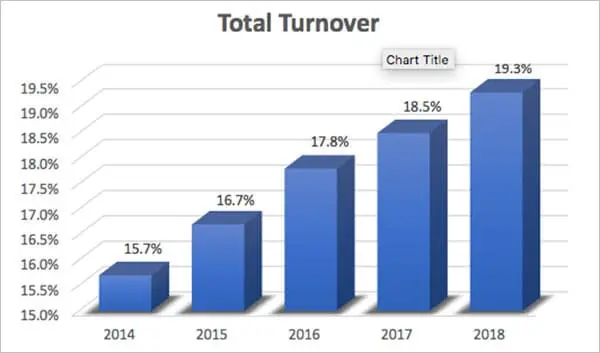The Magic Formula to Calculate Turnover Rate

Are you looking to calculate annual turnover rate for your company? It’s easier than you think once you know the annual turnover rate formula.
In the article, the follow questions will be answered:
- How do you calculate annual turnover rate?
- What are the different types of employee turnover?
- What is considered a high turnover rate?
- What is considered a low turnover rate?
The Growth of Annual Turnover Rates
According to the Salary.com 2018 Turnover Report, company turnover has been on a steady rise, peaking at 19.3% this past year. This is illustrative of a hot job market.

If you want to determine how turnover in your organization compares to average turnover rates in your industry and region, first you need to know how to calculate it.
How to Calculate Annual Turnover Rate
Calculate your annual turnover rate by dividing the number of employees who left your company this year by the total number of employees you had at the beginning of the year. Then show the number as a percentage.
Here is an example of how to calculate total turnover rate:
- Number of employees on January 1st – 250
- Number of employees who left the company from January 1st to December 31st – 40.
- (40 departures divided by 250 employees) x 100 = 16%
Considering the average turnover is 19.3%, in this example you would have had turnover 3.3 points, or 17.1% lower than average (3.3 points divided by 19.3 average turnover).
Using the same math as above, you can calculate annual turnover rate for:
- Voluntary turnover – when an employee willingly chooses to leave their position. This often occurs when an employee finds a more exciting new role or a higher salary. Moves, returning to school, and career changes are also voluntary. In 2018, voluntary turnover nationally was 14.2%Of the 40 people who left, 30 left voluntarily. Thus, the voluntary turnover is 12.0% (calculated as 30 divided the 250 employees you had January 1st x 100).
- Involuntary turnover – When a company terminates an employee from a position. This typically occurs due to poor performance or a layoff. Death, disability and retirement are also considered involuntary. In 2018, involuntary turnover nationally was 5.1%Of the 40 people who left, 10 left voluntarily. Thus, the voluntary turnover is 4.0% (calculated as 10 divided the 250 employees you had January 1st x 100)
Voluntary turnover rate plus involuntary turnover rate will always equal total turnover rate.
And abracadabra. You’ve figured out the trick.
Insights You Need to Get It Right





